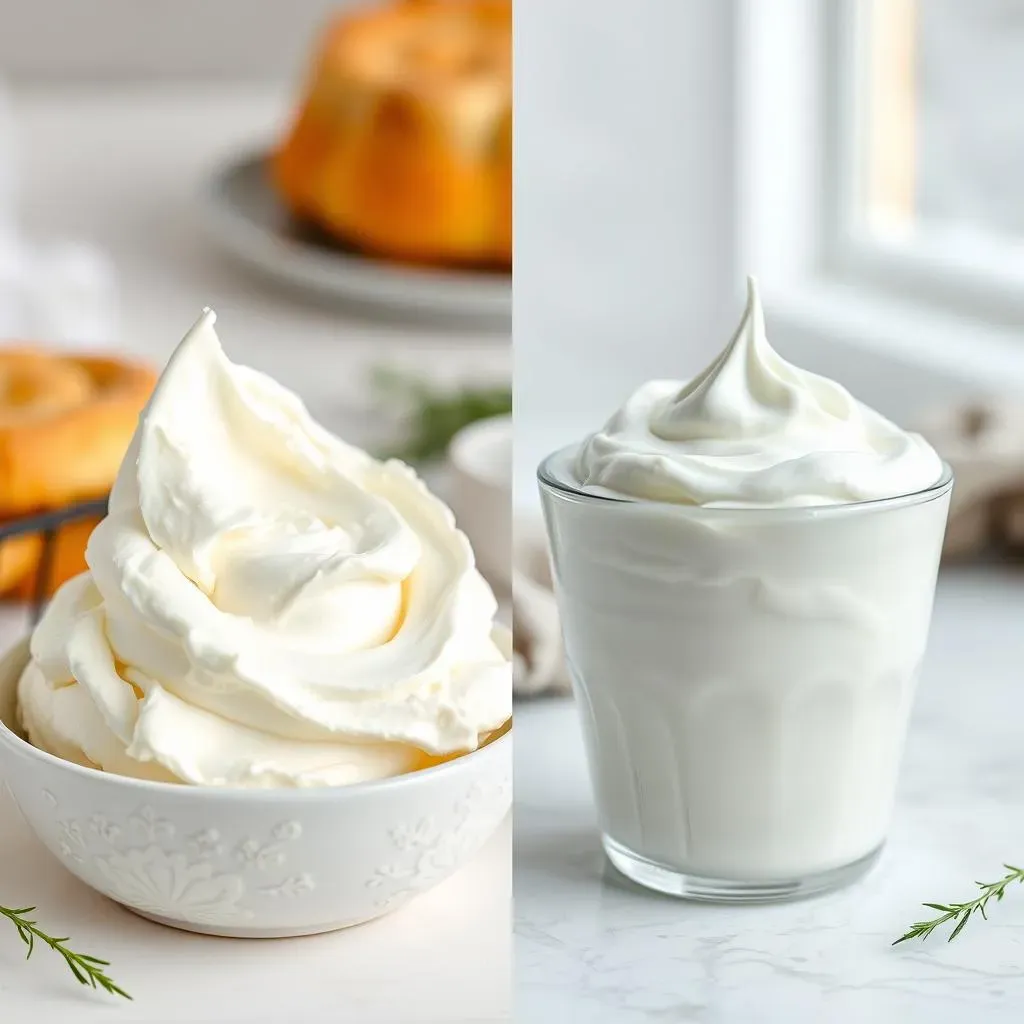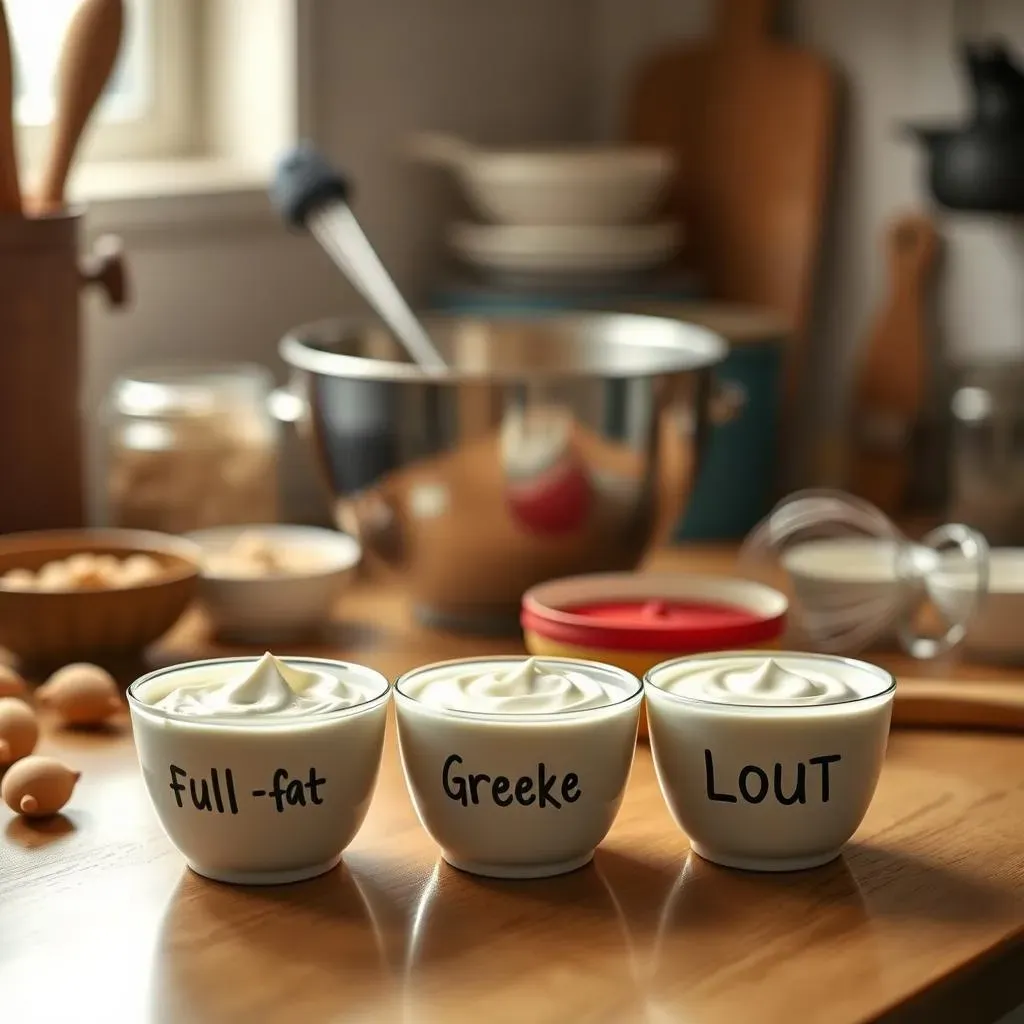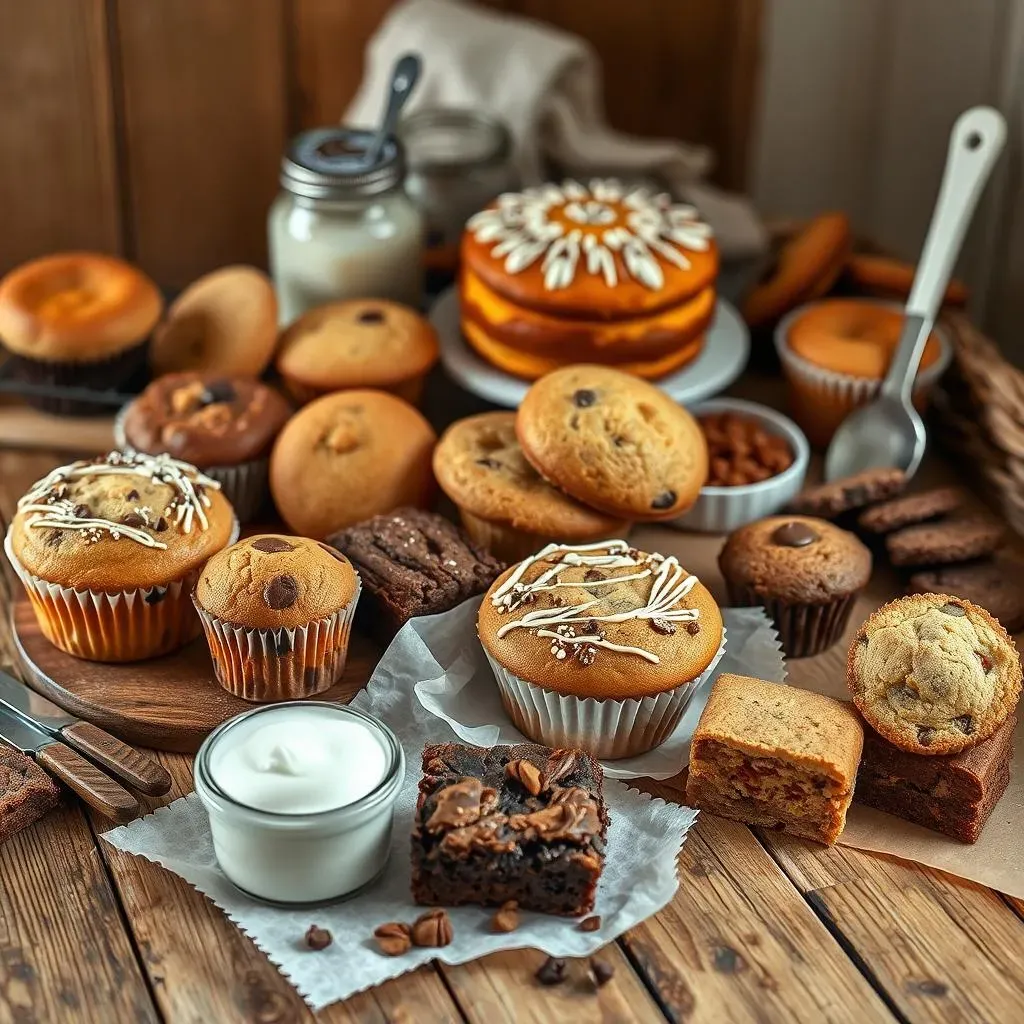Table of Contents
Ever stared blankly at a baking recipe, only to discover you're missing a key ingredient – sour cream? Don't despair, fellow bakers! This article tackles the burning question: "can I substitute yogurt for sour cream in baking?" We'll explore the delicious world of yogurt substitutions, comparing the creamy texture and tangy flavor of sour cream with various types of yogurt. We'll guide you through the best yogurt choices for different baked goods, offering practical tips and tricks for successful swaps. From understanding the nuances of plain versus Greek yogurt to troubleshooting potential issues, we'll equip you with the knowledge to confidently experiment in the kitchen. Get ready to unlock a world of baking possibilities and discover how easy it is to achieve amazing results, even when your pantry's a little light on sour cream! Let's dive in and explore the exciting possibilities of yogurt substitutions in your favorite recipes.
Yogurt vs. Sour Cream: A Baking Showdown

Yogurt vs. Sour Cream: A Baking Showdown
Fat Content and Texture
Let's talk fat! Sour cream is famously higher in fat than yogurt. This fat content contributes to its rich, creamy texture, making it a favorite in recipes where a luxurious mouthfeel is desired. Think of those decadent cheesecakes or fluffy frosting. Yogurt, on the other hand, can range from low-fat to full-fat, but it generally has less fat than sour cream. This difference in fat can impact the final product's texture. For instance, using yogurt in a recipe that calls for sour cream might result in a slightly less dense or tender baked good. Want to learn more about other substitutions? Check out our guide on substituting sour cream for butter!
The higher fat content in sour cream also affects how it interacts with other ingredients in a recipe. It can create a more stable emulsion, preventing separation in things like dressings or sauces. However, this richness can also make a baked good heavier. If you’re aiming for a lighter cake, for example, using yogurt might be a better option. Need a different dairy alternative? Our article on substituting buttermilk for sour cream might be helpful!
Ingredient | Fat Content (approx.) | Texture |
|---|---|---|
Sour Cream | 20-30% | Thick, creamy |
Full-Fat Yogurt | 3-8% | Thick, creamy (but less so than sour cream) |
Low-Fat Yogurt | Less than 3% | Thinner, less creamy |
Acidity and Flavor Profile
Both sour cream and yogurt boast a distinct tang, thanks to their lactic acid content. However, the intensity of this tanginess can vary. Sour cream tends to have a sharper, more pronounced tang compared to most yogurts. This can significantly affect the overall flavor of your baked goods. A recipe relying on the sour cream's sharpness might taste subtly different with yogurt, potentially lacking that signature tang. If you’re substituting, you might need to adjust other ingredients, like lemon juice or vinegar, to compensate.
The type of yogurt also plays a role. Greek yogurt, for example, tends to be thicker and tangier than regular yogurt. This makes it a better substitute in many cases. Plain yogurt is generally preferred for baking because added sugars can throw off the balance of sweetness in your recipe. For more detailed advice on specific yogurt types, check out our ultimate guide on substituting yogurt for sour cream in recipes!
- Sour cream: Sharper, more pronounced tang
- Greek Yogurt: Thicker, tangier than regular yogurt
- Regular Yogurt: Milder tang
Moisture Content and its Effects
The moisture content of sour cream and yogurt differs, which can affect the outcome of your baking. Sour cream is generally thicker and holds its shape better than yogurt. This means it can add a nice moisture to a baked good without making it too wet. Yogurt, especially low-fat varieties, has a higher water content and might lead to a slightly wetter or less structurally sound baked product. This is something to keep in mind, especially when substituting in recipes that are already delicate.
Consider the specific recipe. If it’s a recipe that relies heavily on the structure provided by sour cream, such as a particularly dense cake or a creamy dip, substituting with yogurt might result in a less firm final product. For a more thorough understanding of alternative dairy options, explore our comprehensive guide on substituting sour cream for Greek yogurt. You might be surprised by what you discover!
The Great Yogurt Swap: Types and Techniques

The Great Yogurt Swap: Types and Techniques
Choosing the Right Yogurt
So, you're ready to swap sour cream for yogurt in your baking. Fantastic! But not all yogurts are created equal. The first thing to consider is fat content. Full-fat yogurt will give you the closest texture to sour cream, thanks to its richness. Low-fat or non-fat yogurts, on the other hand, will be thinner and might result in a slightly drier baked good. Think of it like this: full-fat yogurt is the heavyweight champion, while low-fat is the nimble lightweight. Both have their place, but for a direct sour cream swap, go full-fat.
Next up: Greek yogurt. This superstar of the yogurt world is thicker and tangier than regular yogurt, making it an excellent sour cream substitute in many recipes. Its thicker consistency means it won't dramatically alter the texture of your baked goods as much as regular yogurt might. However, its tangier flavor might need some balancing if you're working with a recipe that relies on the milder tang of sour cream. Want to explore more dairy alternatives? Check out our guide on sour cream for Greek yogurt swaps!
- Full-fat yogurt: Closest texture to sour cream
- Greek yogurt: Thicker, tangier, a great all-around choice
- Low-fat/Non-fat yogurt: Thinner, may result in drier baked goods
Adjusting for Flavor and Texture
Even with the "right" yogurt, you might need to make some adjustments to your recipe to achieve optimal results. Remember, yogurt and sour cream have different moisture levels and tang levels. If you're using a low-fat yogurt, you might need to add a little extra oil or butter to compensate for the lack of fat. This will help keep your baked goods moist and tender.
The tanginess factor is also important. If your yogurt is significantly less tangy than the sour cream called for in your recipe, consider adding a squeeze of lemon juice or a splash of white vinegar to boost the acidity. Conversely, if your yogurt is too tangy, you might want to reduce other acidic ingredients in the recipe or add a touch of sweetness to balance things out. For more expert advice, explore our ultimate guide on yogurt as a sour cream substitute.
Yogurt Type | Moisture Adjustment | Acidity Adjustment |
|---|---|---|
Full-Fat | Minimal or none | May need slight increase or decrease |
Greek | Minimal or none | May need slight decrease |
Low-Fat | Add 1-2 tablespoons oil or melted butter | May need significant increase |
Baking with Yogurt: Recipes and Considerations

Baking with Yogurt: Recipes and Considerations
Cakes and Muffins: A Yogurt Delight
Cakes and muffins are fantastic canvases for yogurt's creamy texture and subtle tang. The moisture from yogurt keeps these baked goods tender and moist, preventing dryness. In recipes calling for sour cream, Greek yogurt often shines, offering a similar thickness without overpowering the other flavors. For instance, a lemon poppy seed muffin recipe benefits from the bright tang of Greek yogurt, enhancing the citrus notes. Remember to adjust the liquid content slightly, as yogurt might add a bit more moisture than sour cream. Need more ideas for sour cream substitutes? Check out our guide on sour cream substitutes for mashed potatoes!
For lighter cakes, opting for yogurt instead of sour cream can make a big difference. The reduced fat content can create a more airy crumb structure, which is perfect for sponge cakes or angel food cakes. However, you'll want to ensure you're using a full-fat yogurt to maintain sufficient moisture. Otherwise, your cake might end up a little dry. Thinking about other dairy swaps? Our guide on substituting sour cream for evaporated milk is a great resource!
- Use full-fat yogurt for optimal moisture
- Greek yogurt works well in many recipes
- Adjust liquid content as needed
Cookies and Brownies: A Yogurt Twist
While cookies and brownies might not seem like obvious candidates for a yogurt swap, they can surprise you! Yogurt can add a unique depth of flavor and moisture to these treats. In chocolate chip cookies, for example, the slight tang of yogurt can cut through the sweetness, creating a more balanced flavor profile. It also helps keep the cookies soft and chewy. If you're using a low-fat yogurt, you might need to add a bit more butter or oil to compensate for the reduced fat content.
Brownies, too, can benefit from yogurt's moistening properties. It can create a fudgier, less cakey brownie, with a slightly tangy undertone that complements the chocolate. Experiment with different types of yogurt to find your favorite combination. For additional baking tips and tricks, refer to our complete guide on substituting yogurt for sour cream – it's packed with helpful information!
Recipe | Yogurt Type Recommendation | Potential Adjustments |
|---|---|---|
Chocolate Chip Cookies | Full-fat plain yogurt | Add 1-2 tablespoons of butter if using low-fat yogurt |
Brownies | Greek yogurt | Reduce sugar slightly if yogurt is very tangy |
Quick Breads: The Perfect Match
Quick breads, such as banana bread, zucchini bread, and cornbread, are exceptionally well-suited to yogurt substitutions. The moisture and tang of yogurt enhance the flavors of these breads, resulting in a delightfully moist and flavorful final product. In banana bread, for example, yogurt complements the sweetness of the bananas, creating a perfectly balanced flavor profile. The added moisture prevents the bread from becoming dry and crumbly. For more tips on making delicious quick breads, check out our guide on substituting plain yogurt for sour cream.
The same principle applies to zucchini bread and cornbread. Yogurt adds moisture and a subtle tang that elevates the overall flavor experience. However, remember to adjust the baking time slightly, as the added moisture might affect the browning process. Don't be afraid to experiment and discover your own perfect yogurt-based quick bread recipes! For a deeper dive into various baking substitutions, we recommend exploring our comprehensive guide on substituting sour cream for buttermilk in baking.
Troubleshooting Yogurt Substitutions: Tips and Tricks

Troubleshooting Yogurt Substitutions: Tips and Tricks
Too Dry? Too Wet? Moisture Mayhem!
Sometimes, despite your best efforts, your baked goods might end up a little drier or wetter than expected after a yogurt swap. If your cake is too dry, you might have used a low-fat yogurt and not compensated with enough additional fat. Next time, add a tablespoon or two of melted butter or oil to your batter. If your cookies are too crumbly, the same principle applies – more fat is your friend! Need more ideas on dairy substitutions? Our guide on sour cream for cream cheese swaps might help!
Conversely, if your baked goods are too wet or gummy, you might have used a yogurt with a higher water content than anticipated, or perhaps you didn't adjust for the extra moisture already present in the yogurt. Try reducing the amount of other liquids in your recipe slightly next time. A little experimentation is key – start by reducing the liquid by a tablespoon or two and see how that affects the outcome. For more tips on mastering different baking techniques, check out our guide on cream for sour cream substitutions.
- Dry baked goods: Add more fat (butter or oil)
- Wet baked goods: Reduce liquid amounts
Tang Troubles: Balancing the Acidity
Yogurt's tang can be a blessing and a curse. While it adds a delightful zest to many baked goods, an excessive amount can overpower other flavors. If your baked goods are too tangy, try reducing the amount of yogurt slightly next time. You can also balance the acidity by adding a pinch of baking soda or a touch of extra sugar to neutralize the tartness. Remember, it's all about finding the right equilibrium.
On the flip side, if your baked goods lack that desired tang, you might need to boost the acidity. A simple solution is to add a teaspoon or two of lemon juice or white vinegar to your batter. This will enhance the overall tanginess and complement the other flavors in your recipe. For more detailed information about yogurt's role in baking, consult our complete guide on using yogurt in place of sour cream.
Problem | Solution |
|---|---|
Too tangy | Reduce yogurt, add baking soda or sugar |
Not tangy enough | Add lemon juice or vinegar |
Texture Tweaks: Achieving the Perfect Consistency
Yogurt's texture can differ significantly from sour cream, especially if you're using low-fat varieties. If your baked goods are too runny or lack the desired creaminess, consider using full-fat yogurt or Greek yogurt for a thicker, richer texture. You might also need to adjust the amount of flour in your recipe to compensate for the difference in moisture content. Adding a little extra flour can help thicken the batter or dough.
If your baked goods are too dense or heavy, you might have added too much yogurt or used a type of yogurt that's too thick. In this case, try reducing the amount of yogurt slightly next time or opt for a lighter yogurt, such as regular low-fat yogurt. Remember, finding the perfect balance is key to achieving the desired texture. For more comprehensive guidance on baking substitutions, refer to our extensive resource on sour cream for buttermilk substitutions.